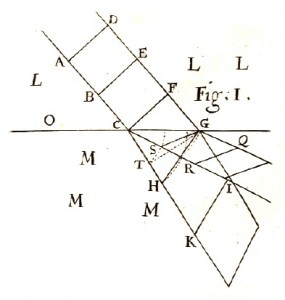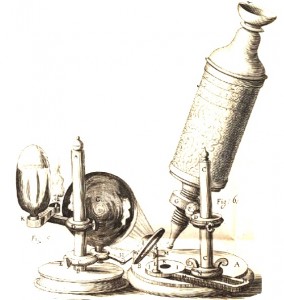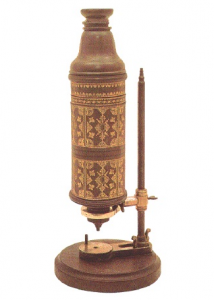This is a guest post by Ian Lawson.
Robert Hooke knew how light worked. He worked with the stuff day in day out during the early 1660s and in Observation IX of his Micrographia (1665) he presents quite a systematic theory of optics.
He presents his theory as the result of a startling observation about the colours of the rainbow observable in thin sheets of muscovy glass (mica). This observation he takes to be an ‘experimentum crucis’ against Descartes’ optical theory, ‘serving as a Guide or Land-mark, by which to direct our course in the search after the true cause of Colours’ (Micrographia, p. 54). His positive thesis starts by outlining a hypothesis about light based on some widely accepted principles (though I won’t go into the details here). This hypothesis he checks against more evidence, this time a glass globe filled with water. He finds his idea consistent with the phenomenon, while Descartes is again lacking. An ‘instantia crucis‘ this time – a sure sign he’s on the right track (ibid., p. 59).
To refine his theory, Hooke continues experimenting. Now he uses water in a long glass tube and sheets of muscovy glass split to varying thicknesses. He adds detail until he feels he can account for all kinds of colour phenomena. ‘By this Hypothesis there is no one experiment of colour that I have yet met with, but may be, I conceive, very rationally solv’d, and perhaps, had I time to examine several particulars requisite to the demonstration of it, I might prove it more than probable…’ (ibid., p. 69).
Hooke presents his theory in an ordered and structured way. First he disproves the leading existing theory, then puts forward his own hypothesis. He returns to experiment to check factual adequacy, and uses further trials to refine the general idea. Focusing on his theory as it is presented, though, makes several features of his account mysterious. Why is it tacked on to the end of an observation about colours in a mineral? Why should colour even be the main part of an optical theory? And given that it is, why does he never mention prisms?
What is worth noting is the experiments and observations Hooke makes. There are four primary apparatus he uses:
1. Muscovy glass
2. Glass lenses with water between them
3. Water globes
4. Glass vials filled with water.
Prisms, that paradigmatic optical experimentation device used by Descartes, Boyle, Power, and Newton in their experimenting about colour, are conspicuous by their absence. Rather, all of the experiments mentioned by Hooke are, in fact, part of his everyday set up for making microscopical observations. Numbers 2) and 4) are simply water microscopes, which he mentions using in the Preface to Micrographia. Number 3) is a scotoscope, used for concentrating light rays onto a small area to provide illumination, and also described in the Preface. And number 1) was Hooke’s preferred choice of microscope slide, as he explains when recounting his replication of Antoni van Leeuwenhoek’s observations in the late 1670s. It is unlikely that someone in possession of mica, ornate microscopes, and with connections among the fellows of the Royal Society as well as the instrument makers of London, was unable to obtain prisms with which to make experiments.
What is more likely is that, having spent four years making microscopical observations, Hooke stumbled again and again upon the incidental production of colours by his instruments. Chromatic aberration was a well known problem in microscopes and telescopes, which would not be solved until Dollond’s innovations in the eighteenth century. But using muscovy glass for specimen slides, and a water globe for illuminating his subjects, exposed Hooke two forms of colour production others may not have noticed. What’s more, in his Preface Hooke provides not only a detailed drawing of his primary instrument, but instructions on how it is made, and other versions suitable for other situations. Hooke doesn’t seem to have thought of his microscope as a static, finished product. Rather, he used one instrumental set up to make observations of distant objects such as the moon, and another to view things nearby and in his control. Even this could vary depending on whether the subject was translucent or opaque, and on the amount of light required to illuminate it. He notes trialling lenses made not just of glass, but resin, gum, oil, salt, and arsenic. All of this points to a man very aware of the behaviour of light and the process of refraction by which objects are magnified, and who was able to alter his instruments for the best results.
Some features of his theory are better explained by noting this likely route to Hooke’s knowledge of light, but a perhaps more difficult historical question is raised. Why did he present his observations as a constructed, systematic theory of colours rather than simply part of a history, as Boyle had done the previous year? It is likely the answer has something to do with ambition and rhetoric, and the role both Hooke and the other Fellows thought Micrographia would play in the early days of the Society.




